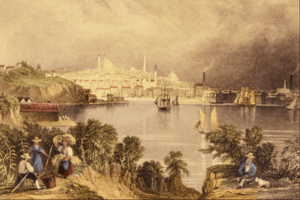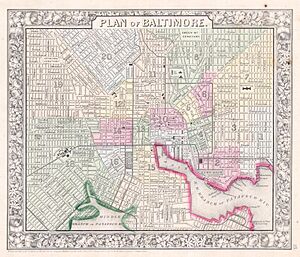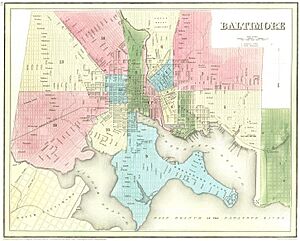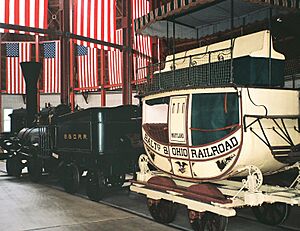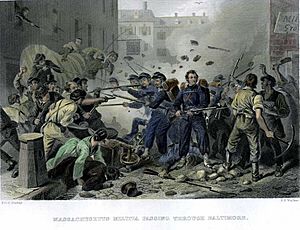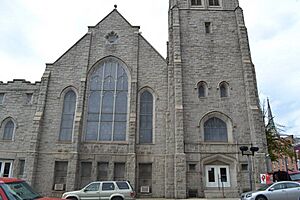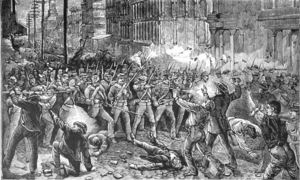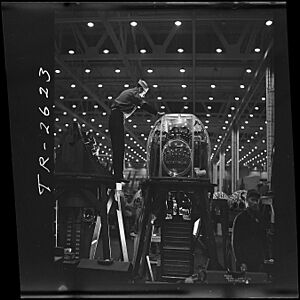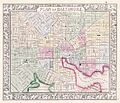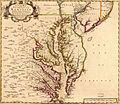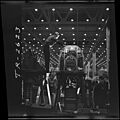History of Baltimore facts for kids
This article shares the exciting history of Baltimore and its nearby areas in central Maryland. It covers everything from the first Native American settlements to how European colonists built the city we know today.
Contents
Early Native American Life
The Baltimore area has been home to Native Americans for a very long time. People lived here as far back as 10,000 BC! Many old sites have been found showing how people lived during different time periods.
In the early 1600s, the land around Baltimore was used for hunting by the Susquehannocks. They lived along the Susquehanna River. Another group, the Piscataway tribe, lived south of Baltimore near the Potomac River.
In 1608, Captain John Smith explored the Chesapeake Bay. He was the first European to visit the Patapsco River. The name "Patapsco" comes from an Algonquian word meaning "backwater" or "tide covered with froth."
About 25 years later, Cecil Calvert, 2nd Baron Baltimore brought 140 colonists to North America. They settled in Maryland. The Piscataway tribe welcomed them, and they formed good relationships.
European Settlers Arrive
Around 1659, the area became "Baltimore County." The first European settler, David Jones, arrived in 1661. He settled in what is now Harbor East. The next year, Charles Gorsuch settled Whetstone Point, where Fort McHenry is today.
In 1665, land on the west side of the Jones Falls river was settled. This area became known as Cole's Harbor. It was later sold and renamed Todd's Range. This land eventually became the main part of Baltimore Town.
There was an earlier "Baltimore" on the Bush River, started around 1674. This first county seat is now called "Old Baltimore." But the port there became too shallow for ships. So, the port moved to the Patapsco River. This new location became the Baltimore we know today.
The Port of Baltimore was officially created in 1706. It was located at the Inner Harbor. Later, it expanded to areas like Fells Point and Canton.
The city is named after Cecil Calvert, 2nd Baron Baltimore. He was the second Lord Baltimore and the founder of the Province of Maryland. The colony itself was named after Queen Henrietta Maria, the wife of King Charles I of England.
How Baltimore Town Grew (1729–1796)
The Maryland government officially created Baltimore Town in 1729. It quickly became a real place, not just a name on paper. Many German immigrants settled here, starting in 1723.
Baltimore Town grew larger in 1745. It took in David Jones's original settlement, called Jones Town. Baltimore became an important community at the head of the Patapsco River. As the town grew, more German immigrants arrived. They built churches and formed groups like the German Society of Maryland to keep their language and culture alive.

The first printing press arrived in 1765. It was brought by Nicholas Hasselbach. His equipment was used to print Baltimore's first newspapers, like The Maryland Journal.
Baltimore grew by draining marshes and building canals. It also added nearby villages like Jones's Town and Fells Point. It became the largest city between Philadelphia and Charleston, South Carolina. The county's main courthouse was moved to Baltimore. This helped the town become even more important.
During the American Revolution, the Second Continental Congress met in Baltimore for a short time. Baltimore merchants helped the war effort by building ships. The war also helped Baltimore's economy. Farming and iron production increased. By 1800, Baltimore was one of the new nation's major cities.
The city's economy grew a lot between 1763 and 1776. Baltimore merchants became very successful in shipping and flour milling. They traded with Britain, Southern Europe, and other colonies. Even with money problems and wars, Baltimore became a busy city by the 1770s.
The population reached 14,000 by 1790. But the 1790s were tough. Money problems and a war with France hurt trade. A yellow fever sickness also made many people leave the city. Because of these challenges, businesses in Baltimore started to focus less on just foreign trade.
Baltimore Before the Civil War (1797–1861)
| Year | 1790 | 1800 | 1810 | 1820 | 1830 | 1840 | 1850 | 1860 |
|---|---|---|---|---|---|---|---|---|
| Population | 14,000 | 27,000 | 47,000 | 63,000 | 81,000 | 102,000 | 169,000 | 212,000 |
In 1797, Baltimore Town officially became the City of Baltimore. It grew very fast. It became the largest city in the Southern United States. Baltimore was a leader in the American flour trade after 1800. This was thanks to new milling technology.
The city was attacked during the War of 1812. After burning Washington, D.C., the British attacked Baltimore on September 12, 1814. But American forces at Fort McHenry bravely defended the city's harbor.
Francis Scott Key, a lawyer from Maryland, watched the battle from a British ship. When he saw the huge American flag still flying the next morning, he wrote the poem "The Star-Spangled Banner." This poem later became the official national anthem of the United States in 1931.
After the War of 1812, Baltimore hoped to become a major cultural center. Writers even called it "the Rome of the United States." The city became known as "The Monumental City." This name came from President John Quincy Adams in 1827. He praised Baltimore's strength and success.
Money and Business
Alexander Brown arrived in Baltimore in 1800. He started a linen business with his sons. His company, Alex. Brown & Sons, grew into a major banking firm. It became the first investment bank in the United States. Brown helped Baltimore's trade with other countries.
The Baltimore & Ohio Railroad
Baltimore needed better ways to trade with the western states. So, in 1827, merchants and bankers decided to build a railroad. The Baltimore and Ohio Railroad (B&O) was one of the first commercial railroads in the world. It was a huge success!
The B&O was the first railroad in the U.S. to get a special permit. It was also the first to use an American-built steam engine, the Tom Thumb, in 1829. It built the first passenger and freight station. The B&O helped Baltimore connect to the Ohio River by 1852.
Other railroads also started in Baltimore. These included the Baltimore and Port Deposit Rail Road and the Baltimore and Susquehanna Railroad. Later, the Western Maryland Railway also began building lines from the city. The first Baltimore-Washington telegraph line was built along a B&O route in 1843–44.
Free and Enslaved People
From the late 1700s to the 1820s, Baltimore was a fast-growing city. Many formerly enslaved people from nearby areas moved there. Slavery in Maryland slowly decreased after 1810. This was because the state's economy changed. Also, new laws made it easier for slaveholders to free enslaved people.
Baltimore had a growing population of free Black people. They often worked alongside enslaved people who were "quasi-freedmen." These were enslaved people who were promised freedom later. There was little conflict with white workers at first. Compared to other cities, Baltimore offered more freedom for both enslaved and free Black people.
Churches and schools helped the free Black community. But after 1840, many German and Irish immigrants arrived. This made it harder for free Black people to find jobs.
Enslaved people in Baltimore often tried to escape to the North. Because of this, slaveholders often promised freedom after a certain number of years. This was to encourage enslaved people to work hard. The number of enslaved people in Baltimore dropped a lot between 1850 and 1860. This showed that slavery was becoming less profitable in the city.
Before the Civil War, Baltimore had the largest community of free Black people in the nation. There were about 15 schools for Black children. These schools were supported by the Black community itself. White people in Baltimore generally did not want Black children to be educated.
Politics in the 1850s
Baltimore had strong political competition in the 1850s. The American Party, also known as the "Know-Nothings," became powerful. This party was mostly made up of Protestants. They were against the Democratic Party, which was supported by many Catholic Irish.
The Know-Nothings took control of Baltimore's government in 1854. They wanted to modernize the city. They improved the police and fire departments. They also used strong-arm tactics and violence on election days. This scared away Democratic voters. But the Irish and Germans fought back.
By 1860, the Democratic government took back control. They arrested some Know-Nothings for election fraud. By 1861, the Know-Nothings were divided over the issue of states leaving the Union.
Baltimore During and After the Civil War (1861–1894)
Lincoln's Journey
There was a fear that President Abraham Lincoln might be attacked while traveling through Baltimore for his inauguration. So, Lincoln traveled through the city secretly at night. It's debated if a real plot existed, but Lincoln and his security team took the threat seriously.
The Civil War in Baltimore
The Civil War divided people in Baltimore and Maryland. Many wealthy people supported the Confederacy. But the large German population in the city hated slavery and supported the Union.
In April 1861, Union soldiers marched through Baltimore on their way to Washington, D.C.. People who supported the Confederacy attacked the troops. This event, known as the Baltimore riot of 1861, was the first bloodshed of the Civil War. Four soldiers and twelve civilians were killed.
After the riot, Union troops occupied Baltimore. Maryland came under federal control to stop it from joining the Confederacy. This lasted until the war ended in 1865.
African Americans After the War
Maryland was not part of the Reconstruction period. But the end of slavery brought new challenges. Many free Black people moved to Baltimore. This led to more competition for jobs and tension with white residents.
The new Maryland state constitution of 1864 ended slavery. It also said that all children, including Black children, should be educated. Schools for Black children were started by groups like the Baltimore Association for the Moral and Educational Improvement of the Colored People. These schools were later taken over by the public school system.
However, the city's school system became unequal. It prepared white students for citizenship but limited education for Black students. Black leaders, like Rev. William Alexander, pushed for equal access to schools. They believed that economic progress depended on it.
Economic Growth
By 1880, manufacturing became very important in Baltimore. The city became a major industrial center. The port continued to ship goods like grain, flour, and tobacco to Europe. New industries grew, such as clothing, canning, and metal products.
Building new homes was a big part of Baltimore's economy. Builders worked with landowners to create new housing. They got money from many sources, including individuals and building societies. These builders helped shape the city.
Baltimore was a mix of different groups of people. White natives, German and Irish immigrants, and Black Baltimoreans lived in various neighborhoods.
In 1877, a major railroad workers' strike started in Baltimore. The B&O company tried to lower wages. The governor called in the National Guard to stop the strikes. But citizens who supported the workers attacked the troops. Soldiers fired into the crowd, killing 10 people. Rioters damaged trains and burned parts of the rail station. Federal troops arrived to restore order.
YWCA
After the Civil War, many immigrants came to Baltimore. This led to the growth of the Young Women's Christian Association (YWCA). The Baltimore YWCA was founded in 1883 for white women. The Colored Women's YWCA was founded in 1896. Both groups later joined together in 1920.
The Progressive Era (1895–1928)
| Year | 1900 | 1910 | 1920 | 1930 | 1940 | 1950 | 1960 | 1970 | 1980 | 1990 | 2000 | 2007 |
|---|---|---|---|---|---|---|---|---|---|---|---|---|
| Population | 509,000 | 558,000 | 734,000 | 805,000 | 859,000 | 950,000 | 939,000 | 906,000 | 787,000 | 736,000 | 651,000 | 637,000 |
Political changes began in the mid-1890s. This was when the powerful Democratic political machine was defeated.
Women's Rights
The Maryland Suffrage Association was founded in 1894. It was one of the first groups in the U.S. to fight for women's right to vote. They worked hard until the Nineteenth Amendment was approved in Maryland in 1941.
Before women could vote, suffragists helped women's rights in other ways. For example, women like Elizabeth King Ellicott and M. Carey Thomas helped raise money for the Johns Hopkins University medical school. They did this on the condition that women would be allowed to attend. In 1893, when the medical school opened, three women were in the first class.
The Great Baltimore Fire

In 1904, the Great Baltimore Fire destroyed 70 city blocks and 1,526 buildings downtown. This led to major rebuilding and city improvement plans. Baltimore had been behind other big American cities in modernizing its public services. But after the fire, the city worked to improve its water and sewer systems. It also made its city government more professional.
Park Planning
The Patapsco Valley State Park near Baltimore has an interesting history. In 1903, experts suggested buying land in the Patapsco Valley for future parks. At the same time, the Maryland State Board of Forestry wanted to use the area for forest research. Over many years, city officials and others bought thousands of acres along the Patapsco River. This area became a special mix of forest preserve and public park.
Baseball in Baltimore
During World War I, many professional baseball players joined industrial baseball leagues. These were company teams, like those at Bethlehem Steel. Fans in Baltimore followed these teams closely. They also watched the famous Baltimore native, Babe Ruth, who was playing for the Boston Red Sox. After the war ended in November 1918, players like Ruth could return to their major league teams.
Residential Segregation
Baltimore's population grew a lot around 1900. The number of African Americans increased from 54,000 to 79,000. Many people moved from the South and rural areas. They often had little money and limited job opportunities. This led to crowded living conditions and the start of slums.
Before this, there were no laws separating where people could live based on race. But white residents became upset when Black citizens moved into their neighborhoods. In 1911, Mayor J. Barry Mahool passed a law to separate housing. Baltimore became the first U.S. city to have a residential segregation law. This law stopped Black people from moving onto blocks where most residents were white. It also stopped white people from moving onto blocks where most residents were Black.
Many other cities copied this law. However, in 1917, the Supreme Court said a similar law in Kentucky was illegal. This meant Baltimore's segregation law was also canceled. But the effects of the law remained.
During World War I, more African Americans moved to cities like Baltimore for factory jobs. Even after the segregation law was canceled, Mayor James H. Preston ordered housing inspectors to report anyone who rented to Black people in mostly white neighborhoods. This made the racial divide in Baltimore even stronger. Later, Baltimore's housing projects were also separated by race. This led to unequal distribution of city resources.
Depression and War (1929–1949)
During the New Deal era, traditional Democratic leaders in Baltimore lost some power. The New Deal programs offered help directly to people, which changed how local politicians gave out favors. Black people, other ethnic groups, and workers started to support new leaders.
World War II
Baltimore was a major center for war production during World War II. Bethlehem Steel's Fairfield Yard built many ships. The Glenn L. Martin Company built aircraft. Many workers moved to Baltimore for these jobs. Most were poor white people from Southern states.
During the war, labor unions grew strong. By 1941, unions had organized most of Baltimore's large industries. By 1945, labor unions and ethnic groups had a lot of power in local politics. Liberal mayors, like Thomas D'Alesandro, Jr., who was mayor from 1947–59, gained support from both Black and white residents.
Father John F. Cronin, a Catholic priest, became a leading anti-Communist. He worked with labor leaders to fight against Communists in the labor movement. He believed a strong labor movement was important for solving Baltimore's social problems.
The Cold War Era
In 1950, Baltimore's population reached its highest point at 950,000 people. About 24% of the population was Black. Then, many white families started moving to the suburbs. This caused the city's population to shrink. The city became home to a higher percentage of Black residents.
Schools
Integrating Baltimore's public schools went smoothly at first. White families moved to suburban schools. By the 1970s, new problems appeared. Many schools that were once white became mostly Black. But most teachers and leaders were still white. The school system also relied on money from the federal government.
In 1974, there were two big problems. A teachers' strike happened because the city didn't want to raise teacher salaries. Raising property taxes would make more white residents leave. Another problem was a federal plan to desegregate schools. This also worried the remaining white residents.
Civil Rights
In the 1930s and 1940s, the local National Association for the Advancement of Colored People (NAACP) chapter, Black churches, and the Afro-American newspaper organized protests. There were no riots during this time.
Read's Drug Store in Baltimore was the site of an early sit-in in January 1955. A few Black students sat at the lunch counter. This event helped start a wave of desegregation.
In the late 1950s, Martin Luther King Jr. and the national civil rights movement inspired Black ministers in Baltimore. They encouraged their communities to fight against local discrimination. Churches helped connect different groups of Black people. Ministers formed networks and motivated people to organize and protest. They often adopted King's ideas of justice and freedom.
Some civil rights activists took on more radical views in the late 1960s. For example, Walter Lively worked to create Black organizations focused on racial and class equality.
1968 Unrest
Unrest broke out in Baltimore's inner city for four nights in April 1968. This happened after news of Martin Luther King Jr.'s assassination. There was burning, looting, and attacks on police. Six people died, 700 were injured, and 5,800 rioters were arrested. Many businesses were destroyed and never reopened.
Governor Spiro T. Agnew sent in 5,000 National Guardsmen. President Lyndon Johnson then sent in 6,000 U.S. Army troops to regain control. This event caused many white residents to move to the suburbs. It also led to a political reaction from white voters. Agnew's comments about the riots helped him become Richard Nixon's vice presidential running mate.
Changes in Politics
In the 1950s and 1960s, racial politics became more intense in Baltimore. White Southerners moved to Baltimore for factory jobs during World War II. They supported the segregated system that had been in place. White workers tried to stop school integration after the Brown v. Board of Education decision in 1954. They felt their interests were being ignored.
Many white working-class voters in Baltimore started supporting the Republican Party. They feared that the Democratic Party's desegregation policies would harm their families and neighborhoods.
Between 1950 and 1990, Baltimore's population dropped by over 200,000. The city's economy shifted from manufacturing to service and knowledge industries. The Inner Harbor area has been improved. It is now a popular place for tourists.
Baltimore in the 21st Century
In January 2004, the historic Hippodrome Theatre reopened after a big renovation. The Reginald F. Lewis Museum of Maryland African American History & Culture opened in 2005. The National Slavic Museum in Fells Point was established in 2012.
On April 12, 2012, Johns Hopkins Hospital completed a huge expansion. It is one of the largest medical complexes in the United States.
Maryland celebrated the 200th anniversary of the War of 1812 and the writing of The Star-Spangled Banner. This was called the "Star-Spangled 200" celebration. It included two big festivals: "Star-Spangled Sailabration" in 2012 and "Star-Spangled Spectacular" in 2014.
These festivals brought many tall ships and naval vessels to Baltimore's Harbor. The Navy's Flight Demonstration Team, the Blue Angels, performed air shows. Important guests like President Barack Obama visited Fort McHenry. Over a million people visited Baltimore during these festivals.
Port Covington Development
On September 19, 2016, the Baltimore City Council approved a huge development project. It was for the Port Covington area. This $5.5 billion project was led by Under Armour founder Kevin Plank. It is one of the largest urban development projects in the country.
The project includes a new headquarters for Under Armour. It also has shops, homes, offices, and manufacturing spaces. It is expected to create 26,500 permanent jobs. Mayor Stephanie Rawlings-Blake signed the bills to fund the project's infrastructure.
Francis Scott Key Bridge Collapse
On March 26, 2024, at 1:28 am, the Francis Scott Key Bridge was hit by a container ship. This caused the bridge to collapse. Sadly, at least 6 people who were working on the bridge died.
See also
- History of Native Americans in Baltimore
- History of African Americans in Baltimore
- History of the Germans in Baltimore
- History of slavery in Maryland
- Islam in Maryland
- Timeline of Baltimore
- List of mayors of Baltimore
- National Register of Historic Places listings in Baltimore, Maryland
Images for kids
-
Map of Chesapeake Bay area by John Senex, 1719, with Baltimore County labeled near Maryland's border with Pennsylvania.
-
View of Baltimore from Chapel Hill, by Francis Guy, 1802-03 (Brooklyn Museum)
-
Child labor at J.S. Farrand Packing Company in Baltimore, 1909. Photo by Lewis Hine.


